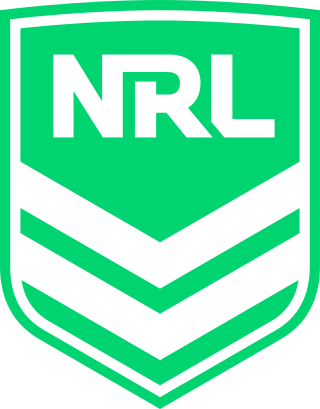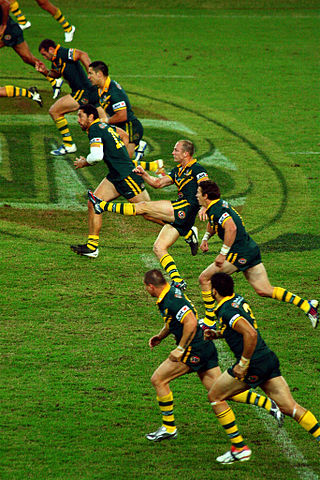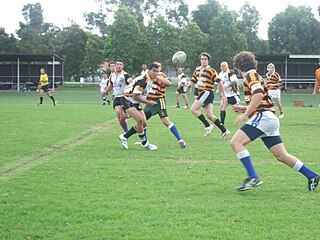Related Research Articles

The National Rugby League is a professional rugby league competition in Australasia which contains clubs from New South Wales, Queensland, Victoria, the Australian Capital Territory and New Zealand.

The New South Wales Rugby League (NSWRL) is the governing body of rugby league in New South Wales and the Australian Capital Territory and is a member of the Australian Rugby League Commission. It was formed in Sydney on 8 August 1907 and was known as the New South Wales Rugby Football League (NSWRFL) until 1984. From 1908 to 1994, the NSWRL ran Sydney's, then New South Wales', and eventually Australia's top-level rugby league club competition. The organisation is responsible for administering the New South Wales rugby league team.

The Queensland Cup, currently known as the Hostplus Cup for sponsorship reasons, is the highest-level regional rugby league football competition in Queensland, Australia. It is run by the Queensland Rugby League (QRL) and is contested by fifteen teams, thirteen of which are based in Queensland, with one based in New South Wales and one in Central Province, Papua New Guinea.

Rugby league in Australia has been one of Australia's most popular sports since it started being played there in 1908. It is the dominant winter football code in the states of New South Wales and Queensland. In 2022, it was the most watched sport on Australian television with an aggregate audience of 137.3 million viewers. The premier club competition is the National Rugby League (NRL), which features ten teams from New South Wales, four teams from Queensland, and one team each from Victoria, the Australian Capital Territory and New Zealand. The premier representative competition is the annual Rugby league State of Origin featuring two sides, the New South Wales Blues and the Queensland Maroons is often referred to as "Australian sport's greatest rivalry", it is one of Australia's premier sporting events, attracting huge interest and television audiences.

Steven Frederick Rogers was an Australian professional rugby league footballer who played in the 1970s and 1980s. He played for the Cronulla-Sutherland Sharks and St. George Dragons teams in the New South Wales Rugby League premiership competition and for Widnes in the English Championship, usually in the position of centre. Rogers represented New South Wales and Australia captaining the national team once in 1981.

Clive Bernard Churchill AM was an Australian professional rugby league footballer and coach in the mid-20th century. An Australian international and New South Wales and Queensland interstate representative fullback, he played the majority of his club football with and later coached the South Sydney Rabbitohs. He won five premierships with the club as a player and three more as coach. Retiring as the most capped Australian Kangaroos player ever, Churchill is thus considered one of the game's greatest ever players and the prestigious Clive Churchill Medal for man-of-the-match in the NRL grand final bears his name. Churchill's attacking flair as a player is credited with having changed the role of the fullback.

Frank Burge was one of the greatest forwards in the history of rugby league in Australia. Later Burge became one of the game's finest coaches. His club career was with Glebe and the St. George Dragons. He represented New South Wales on twenty-six occasions and played thirteen test matches for the Kangaroos and played for Australia in a further twenty-three tour matches.
The 1997 Super League season was a breakaway professional rugby league football competition in Australia and the only one to be run by the News Limited-controlled Super League organisation. Eight teams which had broken away from the existing Australian Rugby League, in addition to the newly created Adelaide Rams and Hunter Mariners, competed over eighteen weekly rounds of the regular season. The top five teams then played a series of knock-out finals which culminated in a September grand final played in Brisbane between the Brisbane Broncos and Cronulla.
The 1961 New South Wales Rugby Football League premiership was the 54th season of the rugby league competition based in Sydney. Ten teams from across the city competed for the J J Giltinan Shield and WD & HO Wills Cup during the season, which culminated in a grand final between St. George and Western Suburbs.
The 1966 New South Wales Rugby Football League premiership was the 59th season of the rugby league competition based in Sydney. Ten clubs from across the city competed for the J.J. Giltinan Shield and the WD & HO Wills Cup during the season, which culminated in a replay of the 1964 grand final between St. George and Balmain.
The 1979 NSWRFL season was the 72nd season of Sydney's professional rugby league football competition, Australia's first. Twelve New South Wales Rugby Football League clubs competed for the J.J. Giltinan Shield and WD & HO Wills Cup during the season, which culminated in a grand final between the St. George and Canterbury-Bankstown clubs. NSWRFL teams also competed in the 1979 Amco Cup.

Rugby league in New South Wales is the most popular spectator sport in the state, with the attendance and television audiences exceeding that of the various other codes of football. There are over 400,000 active rugby league participants, with a further 1 million playing the sport in schools, placing the sport second only to Soccer for the most played sport in the state. There is more than 500 active clubs, ten of which are professional teams competing in the National Rugby League (NRL).
In rugby league football, the Laws of the Game are the rules governing how the sport is played. The Laws are the responsibility of the Rugby League International Federation, and cover the play, officiating, equipment and procedures of the game.

The 2014 NRL season was the 107th season of professional rugby league in Australia and the 17th season of the National Rugby League in Australia and New Zealand. The season started in New Zealand, for the Auckland Nines, replacing the Rugby League All Stars Match for the year, in the pre-season. After 26 rounds of the regular season, the Sydney Roosters were again crowned minor premiers and the competition had been reduced to a top eight teams to contest the finals series. The grand final was won by the South Sydney Rabbitohs, ending a 43-year premiership drought, winning 30–6 against the Canterbury-Bankstown Bulldogs.
Friday Night Football is an Australian sports broadcast of National Rugby League games on Friday evenings.
The 2020 NRL season was the 113th season of professional rugby league in Australia and the 23rd season run by the National Rugby League.
The 2020 NRL season was the 113th of professional rugby league in Australia and the 23rd season run by the National Rugby League.
The Easter Monday match is held annually on the Easter Monday holiday in Australia between the Parramatta Eels and Wests Tigers. It is generally played at Stadium Australia, however Parramatta home matches were held at Western Sydney Stadium from 2019.
The 2021 NRL season was the 114th of professional rugby league in Australia and the 24th season run by the National Rugby League.
George Main was an Australian professional rugby league footballer who played in the 1930s. He played three seasons for Canterbury-Bankstown of the New South Wales Rugby League Premiership. A goal-kicking fullback, Main played for the struggling Canterbury side who were playing their first seasons of professional football.
References
- ↑ "The 6pm game: Why the fuss?". National Rugby League. 2016-11-25. Retrieved 2020-09-21.
- ↑ "2020 NRL Draw". The Roar. Retrieved 2020-09-21.
- ↑ "NRL announces new broadcast deal with Nine, Foxtel". National Rugby League. 2020-05-28. Retrieved 2020-09-21.
- ↑ "The process behind the draw". National Rugby League. 2012-11-12. Retrieved 2020-09-21.
- ↑ "NSWRFL 1920 - Rugby League Project". www.rugbyleagueproject.org. Retrieved 2020-09-21.
- ↑ "NSWRFL 1936 - Rugby League Project". www.rugbyleagueproject.org. Retrieved 2020-09-21.
- ↑ "NSWRFL 1922 - Rugby League Project". www.rugbyleagueproject.org. Retrieved 2020-09-21.
- ↑ "NSWRFL 1925 - Rugby League Project". www.rugbyleagueproject.org. Retrieved 2020-09-21.
- ↑ "NSWRFL 1928 - Rugby League Project". www.rugbyleagueproject.org. Retrieved 2020-09-21.
- ↑ "ARL 1996 - Rugby League Project". www.rugbyleagueproject.org. Retrieved 2020-09-21.
- ↑ "Ladder". National Rugby League. Retrieved 2020-09-22.
- ↑ "Ladder". National Rugby League. Retrieved 2020-09-22.
- ↑ "The new NRL 2020 draw: Everything you need to know". National Rugby League. 2020-05-21. Retrieved 2020-09-22.
- ↑ "Ladder". National Rugby League. Retrieved 2023-06-17.
- ↑ ""Can't get my head around it": Bennett not a fan of rep round axing". Zero Tackle. 2022-06-27. Retrieved 2023-06-17.